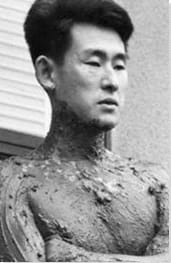Summary of Kazuo Shiraga
Shiraga built his reputation on the back of his involvement with Japan's first avant-garde group, the Gutai Art Association. He pursued a rapport between "body" and "matter" (or the physical and the material), quickly establishing himself as a pioneer in "performance painting". Though abstract, his works tend to be read through the themes of Japanese cultural history and Eastern mythology and, later, through more spiritual ideas that related to his mid-life conversion to Buddhism. Shiraga's spontaneous performative techniques, which gave rise to his famous foot paintings, would influence artists in the West such as Yves Klein and Georges Mathieu, and those working in the Arte Povera and Fluxus movements.
Accomplishments
- Shiraga built his reputation on the back of his involvement with Japan's first avant-garde group, the Gutai Art Association. He pursued a rapport between "body" and "matter" (or the physical and the material), quickly establishing himself as a pioneer in "performance painting". Though abstract, his works tend to be read through the themes of Japanese cultural history and Eastern mythology and, later, through more spiritual ideas that related to his mid-life conversion to Buddhism. Shiraga's spontaneous performative techniques, which gave rise to his famous foot paintings, would influence artists in the West such as Yves Klein and Georges Mathieu, and those working in the Arte Povera and Fluxus movements.
- Shiraga helped establish Gutai as one of the most influential movements in the history of performative and conceptual art, in Japan, and later in the West. At its core, Shiraga's art was an act of impulsive self-expression which was itself representative of the Gutai's collective aim of bringing a new energy and optimism to Japanese art (and life) in the wake of the authoritarian rule that had so suffocated the country during the World War II years.
- Shiraga was responsible for what became perhaps the defining work of the Gutai group, Challenge to the Mud (1955). The "impasto painting" saw the artist, wearing just a loincloth, throw himself into a wet mud mixture (the mud was in fact a concoction of materials including clay and dried cement) and sculpt the matter through violent and unpredictable movement. The performance, which brought Shiraga to physical exhaustion and left a series of wounds on his body, referenced at once the ancient Japanese sumo wrestling tradition, and the bond between the artist and the natural environment.
- In the latter part of his career, Shiraga added "fan painting" to his repertoire. The term "fan painting" might be considered a misnomer given that Shiraga's fans are built from concertinaed paper and wood slats. The fan holds great symbolic significance within Japanese culture and is a feature in Japanese religious ceremonies. Finished by Shiraga in his signature crimson (for him, a symbol of violence) hue, he had effectively transported Japanese tradition into the conceptual realms of the avant-garde.
The Life of Kazuo Shiraga
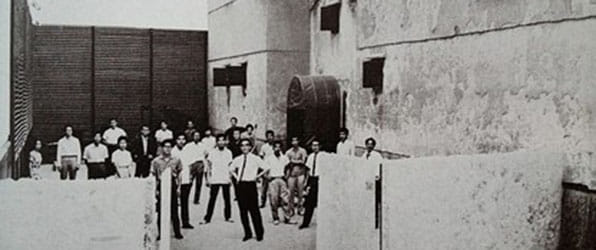
Shiraga, whose spontaneous gestural works are remarkable for their primeval energy, once explained: "I want to paint as though rushing around a battlefield, exerting myself to collapse from exhaustion".
Important Art by Kazuo Shiraga
Challenging Mud
Shiraga enacted his fusion of painting and performance, what scholar Reiko Tomii first termed "performance-paintings," a total of three times at the first exhibition of the Gutai Art Association in 1955. In accordance with the group's stated goal to liberate painting from the arena of the canvas, Shiraga, dressed only in a loincloth, threw himself into a dense mixture of cement, stone, sand, gravel, clay, plaster, and twigs in order to move the mixture around with only his body. Apart from the performance as a work of art in and of itself, the ensuing material's impact from his body from the first and third performances was left on view for the duration of the exhibition.
This performance dates to a year after Shiraga began his first foot paintings. Though those early works on paper have since been lost, he would continue to explore this mode of painting throughout his career. This work can be viewed thus as a derivation of his foot painting in the way it extends the concept of the gestural trace to his entire body. In an essay entitled "Action Only" (1955) Shiraga wrote: "How can an action by me, a living body, confront a dead material? I should use materials that are lifeless-so that the trace of an action is concrete". As only to be expected, this action required a high degree of physical exertion and personal pain that came with the lacerations and bruises on his body.
Historian Dr. Nina Horisaki-Christens makes a further important observation about Challenging Mud. As she says, it was "specifically staged for a Mainichi [a major Japanese newspaper] newsreel. Photographs were also circulated through the Gutai Journal, with several copies ending up in the United States. This led American performance art pioneer Allan Kaprow to include images of Challenging Mud in his seminal compendium of 1960s experimental works Assemblages, Environments and Happenings (1966) alongside art stars Jackson Pollock, Robert Rauschenberg and Claes Oldenburg. Placed amongst other messy, deskilled, immersive, and event-based works, Challenging Mud's performative ephemerality was only captured by the documentary camera and circulated through reproductive media networks. In such a context, Challenging Mud's emphasis on materiality and its challenge to painting fades in favor of the camera frame [...] Ultimately Challenging Mud's complex web of references, at the intersection of the post-WWII Japanese art world and the international art scene, that continues to draw audiences to its photographic remnants".
Performance
Red Logs (Please Come In)
Shiraga first performed Red Logs (Please Come In) at The Experimental of Modern Art to Challenge the Burning Midsummer Sun, at Ashiya Park, and at the 1st Gutai Art Exhibition, both in 1955. Shiraga stood within a structure composed of 10 poles, painted bright red, leaning on one another to form a triangular shape. Performed to an audience, he hit the logs with an axe in order to chip the wood with the emerging "picture" consisting of the exposed cuts underneath the red coat of paint. Shiraga described the work thus: "I thought of the cuts as opening to a picture that could be looked at endlessly rather than seeing the work as something three-dimensional". A sign affixed with the message "Please Enter" encouraged audience members to come inside to view the exposed areas of wood.
The conceptual nature of Shiraga's performance painting have made it difficult to ascribe meaning to his work. But given its time and place of production, critical interpretations of Red Logs have viewed this work in the national context of postwar Japan and the theme of Japanese nationalism. Seen this way, the circular shape formed in the center of the cone, juxtaposed with the logs, has been likened to a sun and its rays recalling the earlier imperial military flag of Japan (discontinued after the loss of the war). Shiraga seems to be engaged in a dialogue with nationalist symbols and Japan's cultural and economic predicament in the aftermath of the war.
Performance
Ultramodern Sanbosō
Shiraga performed Ultramodern Sanbosō at the Gutai Art on the Stage Show at Sankei Halls in Osaka and Tokyo in 1957. A sanbasō refers to the celebratory dance opening the kabuki theater season (kabuki is a form of Japanese dance and drama performed in highly stylized costume and make-up) or a new theater piece in Japan. Accordingly, Shiraga opened the Gutai event with this performance, in which he wore an extended pair of triangular sleeves and a conical red hat on stage. His movements, made against a monotone background, were intended to make the artist himself appear like an abstract composition, effectively creating a performance painting through his exaggerated gestural movements.
This performance is analogous to fellow Gutai member Atusko Tanaka's famed Electric Dress (1956), which was a dress composed of electrical wires and painted neon light bulbs intended to resemble a marriage kimono. Thus, both Gutai pieces functioned as wearable art fusing modern technology and ideas with ancient traditions. Shiraga's piece in particular took the demand for a new kind of Japanese art further than his previous performances by abandoning the use of any kind of paint (or other malleable substance) while still refiguring Japanese cultural history.
Performance
Tenisei Sekihatsuki (Deviance Star Red Haired Devil)
This painting represents a turning point in Shiraga's career. While many of his earliest foot paintings are now lost (given that he created them on paper and deemed them redundant after the performance/exhibition that produced them), Michel Tapié, an influential French art critic involved with tachisme (a style of abstract painting adopted by French avant-garde artists) who traveled to Japan in 1958, encouraged the artist to make some changes while keeping the core tenets of his practice. Up to this point, Shiraga had titled his paintings Sakuhin, or "Work", in accordance with Jirō Yoshihara's Gutai manifesto, but upon Tapié's encouragement he began to title them, sign them, and work on canvas rather than on paper. This approach made his work more durable and brought added commercial benefits too.
With reference to the classic Chinese novel The Water Margin, this painting belongs to the series titled Suikoden, which consists of 106 paintings titled after the Japanese names of the book's warrior protagonists. The warriors were also related to the 108 worldly desires in Buddhism. The novel, which was filled with acts of strong violence, was well suited to Shiraga's conceptual interests in war and blood at this time in his career. The gestural, swirling energetic movement of the artist's feet is most apparent, drawing one's eye across the canvas. This painting, named after a warrior known as the "Red-Haired Devil" in the tale, features the crimson red color he was so drawn to: "The reason I liked it [the crimson] was that it somehow seemed to reek of blood ... I also liked the fact that it was the most transparent paint and that it straddled both dye and pigment".
Oil on canvas
Wild Boar Hunting II
Shiraga created this, one of his most infamous works, out of a desire to instil his works with a greater sense of the grotesque. Although he intended to use the coat of a boar he himself had hunted and killed, Shiraga ultimately purchased his animal hide in order to create this work. Shiraga enacted his foot painting technique on the surface of the hide in a dark palette of reds, alluding to fresh blood, and dark browns and blacks which, having soaked into the hide, resembled blood clots. Other clumps of paint evoke intestines. Hairs and holes in the hide are visible, too, resulting in a discomfiting, overwhelming experience on the part of the viewer. Notably, Shiraga created and planned other works involving the grotesque, even creating a fake animal liver, but Yoshihara opposed these, preferring Shiraga to focus on his foot painting.
In its atavistic, or primeval, allusions to hunting, the work represents the artist's investigation of masculinity and violence that marked the first half of his career. This painting takes Shiraga's dark, bloody palette to its extreme. Other artists, such as the CoBrA group, and some Abstract Expressionists, were also interested in exploring primitive art at this time, but it was perhaps this work that reset the bar for works expressing man's primal instincts.
Oil paint on boar hide on canvas
Untitled (Red Fan)
In the 1960s, Shiraga stepped back from foot painting in favor of what he termed "fan painting" and "squeeze paintings". His "fan paintings" were three-dimensional, consisting of one or more paper fans combined together, while his "squeeze paintings" were created using wooden boards like skis to spread paint, with the wooden stick used like a brush to create a pattern on the surface. This work was exhibited at the 15th Gutai Art Exhibition as well as the 16th Gutai Art Exhibition.
While he referred to them as "fan paintings", the pieces were in fact among the few sculptures the artist created. Shiraga created several iterations of Red Fan in 1965, and later on in the 1960s and 1970s on a smaller scale. The subject matter is in direct conversation with the Japanese cultural symbol - the concertinaed hand-fan is an iconic feature in Japanese religious ceremonies - rendered here in his signature crimson hue. While Shiraga had referred to Japanese traditional culture in other works, in this example, Shiraga is placing this specific national symbol within the conceptual realms of the avant-garde. The piece may also hint at Shiraga's growing interest in religion and as such pre-empts his ordination as a Buddhist monk.
Lacquer on paper and wood
Kannon Fudara Jōdo
Shiraga stopped creating art altogether during his monk training. After his ordination he resumed painting in a modified style that represented the influence of his Esoteric Buddhist beliefs while retaining his earlier feel for energetic movement. Shiraga initially created only monochrome works, but he gradually began to incorporate color. One of his so-called "squeeze paintings", this work was created through the use of quick drying alkyd paint applied to his canvas with a squeegee. Its density is similar to that of house paint, which many Abstract Expressionists in the United States were beginning to incorporate into their art.
The title of this work refers to the island where the benevolent and compassionate Buddhist Water-Moon Kannon (or bodhisattva) lives. Thus, the sensation of a falling waterfall in blues, whites, and some pink and reddish hues across the main portion of the canvas can be interpreted as indicative of its natural location. Shiraga uses his signature red paint in this work too, but it is here devoid of all notions of violence. Shiraga's "squeeze paintings" were an important supplement to his foot paintings and were representative of his new interest in creating more allegorical abstract paintings in a step further from the earlier, more violent, Sakuhin series.
Alkyd paint on canvas
Daiitokuson
This work is an example of one of Shiraga's foot paintings produced after his monk training. The title of this painting refers to Daiitoku Myōō, one of the Five Great Wisdom Kings of Buddhism, who represent the third group of deities after Buddhas and bodhisattvas. As they are representative of the concentric direction of the mandala (an attribute of the deity), the somewhat circular orientation of the swirling paint can be interpreted as alluding to this tenet. An array of colors including red and black lie against a dark green background, while the white flourish is sometimes interpreted as a nod to portrayals of the king on a white cow, which was symbolic of his enlightenment.
While the painting retains a sense of energy and movement, scholar Ming Tiampo identifies a sublime calm (especially when one considers it in lieu of Shiraga's early interest in violence). Before beginning a painting, Shiraga recited sutras in front of a statue of the Buddhist deity Fudō, believing that the power of the deity would infiltrate his paintings. He said, "After this chanting practice, I feel at ease, I feel I can 'entrust it to Fudō". While the explosive splashes and swirls of paint are redolent of a kind of cosmic energy, there is a more peaceful sensibility evident in the more balanced palette. Many artists were becoming interested in Buddhism and Zen Buddhism at this time, and while some critics wonder whether Shiraga's interest was opportunistic, the artist's formal training as a monk proves him to be much more committed to following this path in his art.
Oil on canvas
Biography of Kazuo Shiraga
Childhood
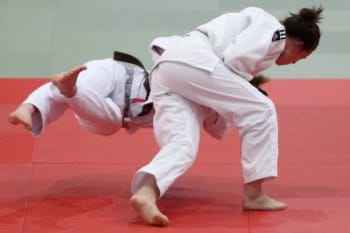
Born in Amagasaki in 1924, Shiraga was the only son of a family of kimono merchants. His father had dreamed of being an artist himself and, as historian Julia Tarasyuk explains, "from early childhood [Shiraga] had access to the marvels of traditional Japanese art: calligraphy and antiques, classical theatre and cinema, ukiyo-e prints and ancient Chinese literature". In 1937, he attended the Hyōgo Prefectural Amagasaki Middle School where he enjoyed reading translations of classical Chinese literature. While in middle school, Shiraga joined a judo club and a yōga (Western-style painting) club. Combining these two hobbies, Shiraga sketched plaster action figures as part of his preparation for applying to art school.
Education and Early Training
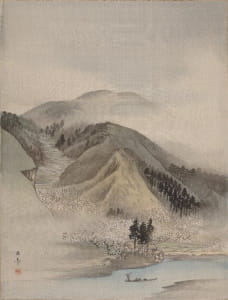
While Shiraga dreamed of attending the Tokyo School of Fine Art, he was obliged to enrolled at the Kyoto Municipal Special School of Painting in 1942 due to the dangers and restrictions of living in the capital at the height of World War II. As the only fine art options offered at Kyoto were design or nihonga, a style that had defined Japanese art since the imperial Meiji period of the turn of the twentieth century, Shiraga chose to concentrate on the latter, though he soon came to react against the figurative and time-intensive nature of nihon-ga. Indeed, Shiraga joined the Gendai Bijutsu Kondankai (Contemporary Art Discussion Group) who wanted to explore techniques in Western painting. As a member of this group, Shiraga began experimenting with the thick density of oil paint which he worked using only his hands and fingers.
In 1944, Shiraga was conscripted into the Japanese army. He never saw combat, but in 1945 was stricken with pneumonia that required a period of more than a year of recuperation. During his recovery, his friend and fellow artist, Akira Kanayama, brought him books on Western painting which Shiraga prized. He also created numerous landscape drawings during his convalescence. Finally returning to his studies, he graduated in 1948 and resumed painting in oil shortly thereafter. He married the artist Fujiko Uemura in the same year, and in 1949, their son Hisao was born.
In 1952, Shiraga co-founded the expressionist Zero Kai (Zero Degree) movement with Kanayama and Saburo Murakami. The group believed that art should be produced from the "point of nothing" leading Shiraga to experiment with automatic techniques using his fingers and fingernails. Laying his canvases on the floor to prevent dripping, he was then inspired to (literally) step into the work, which led to his first foot paintings in 1954. For Shiraga, the tactile, gestural surfaces became "alive" with a true sense of energy and movement.
Introducing an exhibition of his paintings, The Axel Vervoordt Gallery stated, "Central to Kazuo Shiraga's work is the concept of shishitsu. This term primarily means 'innate characteristics and abilities'. Within a philosophical context, the term refers to a psycho-corporeal essence in ourselves that defines us and shapes us over time as individual human beings. For Shiraga [...] making art was a way of fully connecting with one's own shishitsu and making it resonate through paint. In his quest to transport the essence of human energy into matter, and to feel one with the empty canvas, he invented his own form of action painting".
To avoid slipping, Shiraga would dangle from a rope which was hung from a makeshift wooden scaffold in his studio. His wife Fujiko, who had suspended her own career to support her husband and to raise their son, became very involved in this process. She would pass her husband paint and help him decide when a work could be considered finished. Shiraga stated: "This act of painting with my feet feels very important to me. It felt as though the scales dropped from my eyes. I felt cheered up, happy, and exhilarated".
Mature Period
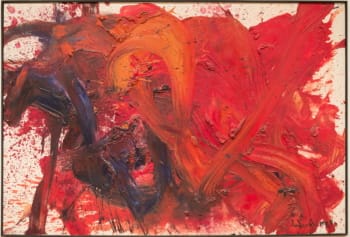
In 1955, the Zero Kai group merged with the Gutai Bijutsu Kyōkai (Gutai Art Association). As Christie's post-war and contemporary art specialist, Paul Nyzam, writes, "The Gutai group initially consisted of around 20 young artists who were brought together in the town of Ashiya, near Osaka, by Jiro Yoshihara, the scion of a family made wealthy by food oils. Their ambition was to fill a perceived cultural void left by the atrocities of the Second World War and the aftermath of the atomic bomb". Yoshihara admonished group members, chief amongst whom were Shiraga, Murakami and Sadamasa Motonaga, to "Never imitate others! Make something that never existed".
![Jirō Yoshihara, painter, educator, curator, and leader of the Gutai Art Association. Nyzam wrote, “Yoshihara [...] was a keen disciple of American post-war art and painted in a manner similar to Abstract Expressionism”.](/images20/photo/photo_shiraga_kazuo_4.jpg)
The word Gutai translates roughly to "concreteness" which was indicative of the group's willingness to work with a disparate range of materials such as tar, glue, mud, paper, and paint. Yoshihara stated in the group's manifesto: "Gutai art does not change the material but brings it to life. Gutai art does not falsify the material. In Gutai art the human spirit and the material reach out their hands to each other, even though they are otherwise opposed to each other. The material is not absorbed by the spirit. The spirit does not force the material into submission. If one leaves the material as it is, presenting it just as material, then it starts to tell something and speaks with a mighty voice. Keeping the life of the material alive also means bringing the spirit alive, and lifting up the spirit means leading the material up to the height of the spirit".
Shiraga began to create and enact performances analogous to painting in addition to creating his abstract foot paintings, primarily in a "violent" crimson red, which became his "signature" color. His art amounted to a celebration of abandon and individualism and was a direct a riposte to totalitarian war years. It was with the Gutai that Shiraga produced his seminal work, Challenge to the Mud (1955). It was a "performance painting" in which Shiraga, wearing only a loincloth, threw himself into wet mud and sculpted the wet earth (a mixture including dried cement and clay) in a performance that used the whole of his body. The work alluded to the Japanese sumo wrestling tradition and a struggle between the artist and the natural environment. Shiraga then followed with a few installations. As art historian Julia Tarasyuk explains, "installation pieces including the Red fluid cattle liver piece from 1956 highlight the artist's wider practice [while other pieces] made from urethane and wood [...] aimed to encourage direct action by viewers, activation by touching and pushing".
Late Period
New York's Fergus McCaffrey Gallery states that Shiraga had been "first introduced to the American public under the auspices of a Gutai exhibition held at Martha Jackson Gallery, New York, in September 1958. His work was dismissed as derivative and his great originality went unrecognized, in what amounted to an extraordinary misreading. However, having realized a means so unmistakably his own, Shiraga continued to refine and rework his signature style for the remainder of his long career, creating challenging paintings of visceral energy and visual power".
In Nyzam's view, Shiraga was the "predominant force" in the Gutai movement's first phase which ran from 1954 to 1961. However, by the time of the onset of the second phase (1961-72), when the group merged with the international Art Informel movement, Shiraga was beginning to exhibit independently of the Gutai. His rising star was due largely to the influential French critic and collector, Michel Tapié (also the promoter of Art Informel) who was the great champion of Shiraga's work. (Even though he became recognized more and more as a solo artist, he continued to contribute to Gutai exhibitions until the group's dissolution.) Joan Kee, associate professor in the history of art department at the University of Michigan, suggests that Shiraga had emerged from the group as its "top billing". She writes, "His works from the early '60s are particularly intense: The brashness with which he treated paint appears to have come less from spontaneity than from a deliberate effort to outdo the posturings of the contemporary French painting movement Informel".
In 1961 Shiraga painted Chijikusei Gotenrai, which was described by Scott Reyburn of the New York Times as introducing the artist's "prime period" (it sold in 2015 for a record $3.7 million for a Shiraga work). As the decade progressed, Shiraga would expand his range of topics. The bloody and violent, Wild Boar Hunting II (1963), represented Shiraga's interest in primitivism and hunting. As Kee describes, "two boars' hides are flattened onto a canvas and smeared with pigment. Death prevails in all its messiness, a point Shiraga emphatically makes by adding spent bullet casings to the canvas". By the mid-'60s, Shiraga was exploring other ways of painting, too, including so-called "squeeze paintings", in which Shiraga used squeegee and wooden ski-like devices to apply paint to canvas, and "fan paintings" which were three-dimensional works made from paper and wood. The concertinaed sculptures were then finished by Shiraga with a crimson red lacquer.
In 1971 Shiraga was ordained as an esoteric Buddhist priest. It is a form of Buddhism that promotes trance-like meditation and Shiraga began to paint while in this mental state. His foot paintings of this period, such as Daiitokuson (1973), were thus the product of a blurring between the conscious and unconscious. Shiraga's foot paintings, which he continued to produce throughout the remainder of his career, retained the artist's preference for vitality and movement, but the Buddhist influence brought a distinctive element of balance and calm to his work. Indeed, his earlier emphasis on crimson ("to stir the blood of the viewer") gave way to a broader, calmer, color palette.
In the closing years of Shiraga's career, the artist's paintings became less allegorical and more contained. And although these pieces might have lost some of the thrusting angry energy of his earlier works, the sunny yellows and whites in works such as Chimosei Hakujitsuso (Daylight Rat Incarnated from Earthly Wasted Star) (2001) suggest the physical and spiritual equilibrium he had reached in his last years. Shiraga died of sepsis at home, in Amagasaki, on April 8, 2008, aged 83.
The Legacy of Kazuo Shiraga
As a leading member of the Gutai group, Shiraga, produced radical abstract art that bridged the division between body and matter. As the Christie's Auction House states, "Thanks to a new wave of scholars and curators [the Gutai are] now being recognised for producing a lasting legacy that in its first phase anticipated Arte Povera and Fluxus and in its second phase anticipated conceptual art, most notably the artists of the Zero movement, an international network of European artists who shared Gutai's aspirations to transform and redefine art".
Individually, Shiraga's performance painting placed him the company of avant-gardists of the calibre of Yves Klein, Robert Rauschenberg, Cy Twombly, and Georges Mathieu who were collectively seeking to make art that stretched beyond the boundaries of Abstract Expressionism. London's Delahunty Gallery goes further, stating that Shiraga's work was "the natural antecedent of all contemporary conceptual, installation and performance work. Even if he did not use the word, his performances were undoubtedly 'happenings' and his legacy lived vividly on in the work not just of Yoko Ono but [also] Allan Kaprow".
Influences and Connections

-
![Jackson Pollock]() Jackson Pollock
Jackson Pollock -
![Franz Kline]() Franz Kline
Franz Kline -
![Jean Dubuffet]() Jean Dubuffet
Jean Dubuffet - Fujiko Uemura
- Akira Kanayama
- Saburo Murakami
- Jirō Yoshihara
- Michel Tapié
- Akira Kanayama
- Atsuko Tanaka
- Saburo Murakami
- Sadamasa Motonaga
 Ask The Art Story AI
Ask The Art Story AI